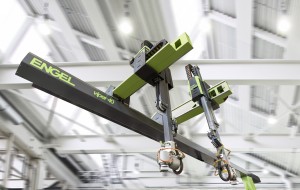Faster positioning for shorter cycle times
07.11.2016
Thanks to the new active vibration control, the ENGEL viper linear robots not only detect their own oscillations, but can also react to vibrations that are caused by external influences. Actively compensating for oscillations during the running process increases positioning speed and reduces cycle time. At Fakuma 2015, ENGEL was setting a new trend with this development.
Thanks to the new active vibration control, the ENGEL viper linear robots not only detect their own oscillations, but can also react to vibrations that are caused by external influences. Actively compensating for oscillations during the running process increases positioning speed and reduces cycle time. At Fakuma 2015, ENGEL was setting a new trend with this development.

In mobile phones, 3D motion sensors have long become standard equipment. Now the ENGEL viper robots also use this technology and thus significantly boost their performance and efficiency. While up to now, the robots own expected oscillations were calculated for vibration control, external influences can now also be compensated for online. Thus the robots now also make a contribution to help the injection moulding process continuously optimise itself and make production smarter in the sense of Industry 4.0.
Thanks to the active vibration control, the ENGEL viper robots reach a stable working position more quickly and operate with significantly greater positioning accuracy, which is important for such tasks as placing insert pieces or transferring pre-moulded parts.
Perfect synchronisation of far more than twelve axes
An ENGEL viper 40 double robot gave an impressive demonstration of this at Fakuma 2015. The respective grippers held a sleeve and a corresponding core. The two robots with a common Z-axis rotated the two parts together, inserting one inside the other and separating them again multiple times within a very short time without the sleeve and core touching each other. In addition to the active vibration compensation, another advantage of the ENGEL viper robots came into play: the perfect synchronisation of independent movements. Each of the twin robots had three NC and three servo rotation axes. During the exhibition, a total of twelve axes were controlled synchronously – which is far from exhausting all the possibilities.
All ENGEL viper robots will be equipped with active vibration control starting from size 20 up to the largest ENGEL viper 120 robots with a load capacity of 120 kilograms. The ENGEL viper 40 and 60 robots made the start in time for Fakuma 2015.
New drive package for more efficient dynamics
In revising its linear robot series, ENGEL has not just increased the positioning speed, but has also boosted the overall performance and efficiency. The new multidynamic drive package ensures that the robots automatically adapt their dynamics to the real weight load. Thus the ENGEL vipers operate faster when bearing lighter loads and slower with heavier ones. The efficiency control function also takes the cycle of the injection moulding process into account. Within only three cycles, the ENGEL viper achieves the optimal dynamics for the respective injection moulding process, for example by reducing its own speed corresponding to a long cooling stage without increasing the overall removal time. While the machine operator previously had to calculate the optimal handling speed for each process individually and set it manually, the ENGEL viper robots now automatically manage this themselves.
All these measures make significant contributions that reduce overall cycle times and boost energy efficiency. Beyond that, the mechanical components are given the best possible protection against wear, making longer maintenance intervals possible and yet still ensuring long lifetimes.
Complete integration makes it easy to master complex processes
The dynamics of the market constantly create new challenges for the injection moulding processors. ENGEL automation provides custom-fit solutions for all applications from simple pick-and-place tasks up to highly-integrated, multiple-stage production processes. What makes ENGEL solutions special is the fact that all components – injection moulding machines, linear and multi-axis robots – harmonise perfectly with each other thanks to their common CC300 control platform, and an existing solution can be easily expanded or set up for a different task at any time.
The CC300 relies on a simple operating concept and intuitive user interface. To achieve this, the robot controls are integrated into the controls of the injection moulding machine as a subsystem of the CC300 so that machine operators no longer need to familiarise themselves with separate control logic concepts. The additional movement instructions for the robot integrate seamlessly with the graphical user interface of the machine control unit, which considerably simplifies above all the programming and operation of complex process workflows and makes an additional PLC unnecessary. To allow for fast parameterisation despite the complexity of the overall system, the CC300 control unit provides the user with different ways of visualising the process sequence, from the simple choice of preprogrammed standard sequences to the object-oriented graphical creation of complex process sequences.
Not only machine and robot merge to become one unit without requiring extra hardware, but also further peripheral equipment like conveyor systems, laser units or optical systems. In the fully integrated solutions, all components of the manufacturing cell access the same shared database. This reduces the risk of data-entry mistakes and further optimises the overall efficiency because all components automatically coordinate their movement sequences and feedback loops with each other.




































